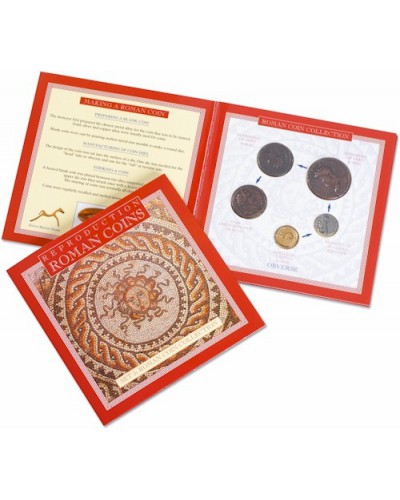Product Description: These reproduction Aureus of Claudius, Denarius of Augustus, Sestertius of Nero, Dupondius of Nero and As of Antoninius Pius coins are moulded directly from original coins and are made from pewter. The gold aureus is 22ct gold plated and the Sestertius, As and Dupondius are bronze finished. The pamphlet style packaging has holes on the centre page in which the coins are held in clear blisters. The coin pack has an image of a Roman mosaic on the front and further Roman images inside. The pack includes information about how coins were made, how they were used as newspapers and the different denominations.
Information: The moneyer first prepared the chosen metal alloy for the coin that was to be minted. Gold, silver and copper alloy were usually used for coins. Blank coins were cast by pouring molten metal into moulds to make a round disc.
The design of the coin was cut into the surface of a die. One die was needed for the “head” side or obverse and one for the “tail” or reverse side.
A heated blank coin was placed between two dies, supported on an anvil and the upper die was then struck once with a heavy hammer. The minting of coins was normally done by hand. Coins were regularly recalled and melted down to make new issues of coins.
In the days before television, radio and newspapers, getting information around such a large area as the Roman Empire was no easy matter. Coins were a good way of getting various ideas and propaganda across to the general populace.
Firstly, the obverse of the coin portrayed the ruling emperor’s face. This was useful in getting across what the emperor looked like. Some emperors also put members of their families on the coins.
Most of the information was on the reverse of the coin. Deities of the roman Pantheon appeared frequently on the reverse of the Roman Coins. They were used when the emperor wanted to be associated with an attribute of the deity e.g. Minerva Pacifera (bringer of peace).
Animals or Mythological beasts occur quite commonly on Roman Coins. Some animals appeared because they were connected with a deity. On the Denarius of Augustus there is a Capricorn on the reverse side. This signifies his birth sign. Other animals were used to show strength or courage.
Buildings are not uncommonly shown on Roman Coins. Temples frequently appeared on the coins of Nero and Antoninus Pius. Military buildings were also depicted.
The letters SC were also found on the reverse of Roman Coins. This meant Senatus Consulto (with authority of, or by decree of, the Senate).
Tags: Coin Set, Roman Coin Collection, Claudius, Augustus, Nero, Antoninius Pius, Coin Pack, Pewter, Gold Plated, Bronze, Roman

